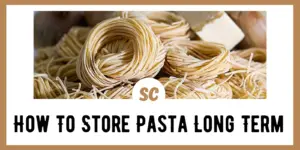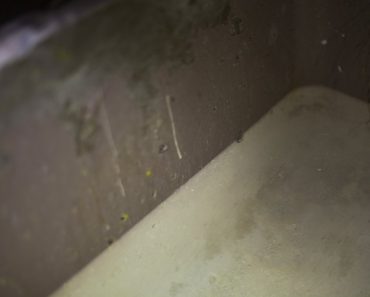Pasta is one of my favorite foods to have in case of an emergency because it’s affordable, a little bit goes a long way, I can use it in a lot of different recipes, and when it’s stored properly it can last a long time!
Another benefit is that, unlike some foods, there are several methods that can be used for long-term pasta storage, which gives you more options if space or budget are concerns.
Before getting into the methods for pasta storage, it helps to know what things effect the shelf life of pasta, as well as other dry foods, so that you can avoid items in your pantry from going bad.
In this article, we’ll break down:
- What makes pasta go bad (and how to avoid it)
- Pasta storage options
- How much pasta to keep on hand (and other FAQs)
What Makes Pasta Go Bad?
There are five main enemies that will affect the shelf life of pasta. They are: air, moisture, temperature, light, and pests.
Oxygen, moisture, and light all contribute to the growth of bacteria, pests, and mold – so you want to remove as much air as possible from the equation.
Temperature will also contribute to this, but food stored at high temperatures for prolonged periods may also begin to have nutritional break down. Cooler temperatures are better for long-term pasta storage.
External pests, like insects and mice can chow down on your stored pasta if it isn’t properly protected. This is why it is important that when you store food, it is placed in a hard container that critters can’t get into.
Also, over time, pasta can start to absorb smells and other components from its environment. This will can give pasta a strange smell and taste if you don’t store it in a sealed container.
When storing pasta, there is sometimes the concern of insect eggs in the food or packaging. I have yet to have a problem with this, but one way people deal with this is to put dry foods in the freezer for a few days prior to preparing it for long term storage. When you freeze pasta, this can help to neutralize the problem.
So, a quick recap:
You want to store your pasta in a sealed container that will protect it from air, moisture, light, and pests. You also want to keep it in a fairly cool location.
Different Types of Pasta
There are, of course, different types of dry pasta, such as:
- Egg noodles or egg pasta
- Vegetable pasta
- Semolina pasta
- Flax pasta
- Whole grain pasta
- Gluten-free pasta
- Buckwheat noodles
- And more!
And just because they are all types of pasta, doesn’t mean they all have the same shelf life.
The ingredients in the pasta will be a big part of determining its shelf life. Whole grain pasta for example, tends to have more oils in it, which can become rancid. This makes the shelf life of whole grain pasta around 6 months.
On the other hand, semolina pasta doesn’t have nearly as much oil in it. Under normal conditions, it can have a shelf life of two years and ten plus years under the right conditions.
So, because of the oils, whole grain pasta won’t have as long of a shelf life as semolina pasta, which doesn’t have as much oil in it.
What ingredients are used in the dry pasta are an important consideration when your goal is long term food storage.
Original Packaging Must Go!
Most food at your local grocery establishment is not stored in packaging meant for long term – except for canned goods.
“Why not?” many people ask.
Well, most shoppers don’t go to their local grocery store to buy food that’s going to last ten years. It’s usually going to be eaten that day, that week or at most, within 6-12 months.
A lot of store-bought dry pasta comes in either cardboard boxes, or a plastic bag.
Cardboard boxes are not good oxygen or moisture barriers, nor do they protect against pests. The plastic bags are usually very thin, and they tear extremely easy. Plus, these types of bags are not a good barrier against light or oxygen.
This means you are going to have to remove the food from the original packaging and repackage it in something that will last and protect the dry pasta long term.
How to Store Pasta Long Term
Under the right conditions, some pasta can have a shelf life of many years and even decades!
To increase pasta shelf life, keep in mind the elements that make pasta go bad, and that you have to remove it from its original packaging.
Freeze Drying
The absolute best way to preserve food long term is through freeze drying. This process removes almost one hundred percent of the water content in the food through a process called sublimation.
Once this is done, the dry pasta can be placed in an airtight container with oxygen absorbers – usually mylar bags (it helps if the bag is vacuum sealed) – and food grade buckets. Freeze dried pasta can last for decades and only requires some water to bring it back to life.
The downside to freeze drying food is that the equipment needed for it isn’t cheap. A home version can cost several thousand dollars, making it a not so budget friendly option for most people.
Pros
- Provides a very long shelf life
Cons
Canning Jars
Using canning jars to extend pasta’s shelf life is another popular method. Pasta can be made into salads, soups, and other premade recipes that may make it more appetizing and convenient when it comes to mealtime. But, doing so may shorten the shelf life.
Dry canning can be done with just some canning jars and oxygen absorbers. Simply pack a jar with your favorite dry pasta, drop in oxygen absorbers, and seal the lid. However, a better option involves putting the filled glass jars in the oven to heat them.
Canning jars are a popular container for long term storage because they create a vacuum seal, the jars can be reused, the contents are easily visible, and it’s a relatively affordable and easy process.
While canning jars are a great option, they aren’t a good barrier against light. And, as durable as they are, they will break if dropped.
Pros
- Stored pasta in canning jars can either be wet or dry pasta
- Affordable food storage option
- Long shelf life
- Canning jars are able to form a vacuum seal, providing an airtight container
Cons
- Will break if dropped
- Not a good barrier against light
Vacuum Sealer
Vacuum sealing is another affordable, easy way to store pasta, because using a vacuum sealer is so easy.
To use this method, dry pasta is placed into a food safe bag and attached to a vacuum sealer. The majority of the air will be sucked out and the open end of the bag is automatically sealed shut. This process removes as much air as possible, which prolongs the shelf life of any food.
I have used a vacuum sealer in the past for pasta storage and it worked okay, but I ran into two problems:
The first is that over time, the plastic bags eventually started to leak air.
Secondly – and this could be due to me having cheap material – the dried pasta can develop sharp edges, which can puncture small holes through the plastic, thus leaking air.
I liked using a vacuum sealer on these bags for short to moderate periods when it comes to food storage, but I don’t think I would expect ten years from a food vacuum sealer – at least not the one I used in the past.
Pros
- Vacuum sealing pasta is an affordable option
- Vacuum sealing pasta and using the vacuum sealer is an easy process
- Provides a longer shelf life than the original packaging
Cons
- Plastic bags susceptible to puncture
- Clear bags are not a good barrier against light
- May not provide a 100% air-tight seal
Mylar Bag Method
Mylar bags are basically plastic bags with a metallic coating. This coating provides a fantastic barrier against air, light, and moisture.
Mylar bags and accessories (oxygen absorbers/ desiccants) are reasonably priced and easy to use at home. Storing dry pasta for long term in a mylar bag is extremely easy.
Take a mylar bag, stand it upright, and place your dry pasta of choice inside. Once the pasta is inside, you can add oxygen absorbers and the bag is sealed shut with a sealer. Commercially-made mylar bag sealers are available, but they are a bit expensive.
If you are on a budget, you can use a clothes iron (or in my case, my wife’s hair straightening iron) to create sealed bags. Vacuum sealing a mylar bag will also help to increase the shelf life.
Pros
- Easy to do
- Mid-range affordability
- Provides a very long shelf life
Cons
- Bags are susceptible to puncture
Long Term Storage Containers at a Glance
To summarize, here are some of the best containers, materials, and methods to store pasta long term:
- Vacuum sealing method
- Dry canning method in mason jars
- Wet canning method in mason jars
- Mylar bags
- Oxygen absorbers
- Airtight container (a vacuum seal is best)
- Food grade buckets, which is a type of food grade plastic
- Jar sealer attachment
FAQs
How much pasta is needed for a one-year supply?
This really depends on how much pasta a person wants to eat. On average, a person consumes around twenty pounds of pasta annually.
To figure out how much you need for a year, take the amount of pasta you eat in one month, multiply that number by 12, and that will be the amount of dry pasta you need for a one-year supply.
Does the shape of the pasta effect its shelf life?
Dry pasta comes in all shapes and sizes. From long thin spaghetti noodles to bowtie pasta. While I am not one hundred percent certain, I would say that the shape of the pasta probably doesn’t have an effect on its shelf life.
Can you eat dry pasta?
Sure, but dry pasta isn’t all that tasty, and it can be hard on your teeth and gut. Also, since it is so dry, it will absorb a lot of water from your body. You’re better off cooking it!
What is a food grade bucket?
Food grade buckets are buckets that are made with a type of plastic that is considered “food safe.”
This means it is okay for food items that are going to be consumed to come into contact with the bucket.
Food grade buckets are great for storing pasta in because they come in different sizes, are easy to transport, provide physical protection, and can be an airtight container.
Food grade buckets are generally more expensive than a regular bucket that you pick up at a hardware store. However, when it comes to the containers you are going to use for long term storage, food grade buckets are worth the investment.
What are oxygen absorbers?
They are small packets that are placed into sealed containers with food. The packets contain a material that absorbs moisture and oxygen from its surroundings. The less oxygen there is in a container, the longer shelf life your food will have.
My Choice
All of these are pretty good options for increasing the shelf life of pasta, but if I had to choose just one, I’d probably go with mylar bags.
I would love to get the equipment for freeze drying, but it’s just too expensive and I think most people would agree.
I loved having my vacuum sealer, but for some reason it just didn’t work well for me to store dry pasta in, which could have been my fault and not the process itself.
Glass jars are a good option, and the canning process does provide a vacuum seal. But if you plan on storing pasta in large amounts, jars can break and are kind of a pain to transport.
On the other hand, a person can get set up with mylar bags without spending much money, they can learn how to do it quickly, and the pasta will have a long shelf life from the results.
If you can, I would suggest that you purchase pasta in bulk and fill many bags at once. This is a great way to start increasing your pasta stores in a short time without it hurting your wallet too much.
All of the methods discussed in this article are going to require a bit of an investment to get started in. But the great thing about these methods is that they aren’t specific for storing pasta, but can be used to store other dry foods as well.
Thanks for reading and stay prepared.



















![Rural vs Urban Prepping [PODCAST]](https://survivalcove.com/wp-content/themes/mts_sociallyviral/images/nothumb-sociallyviral-featured.png)





















